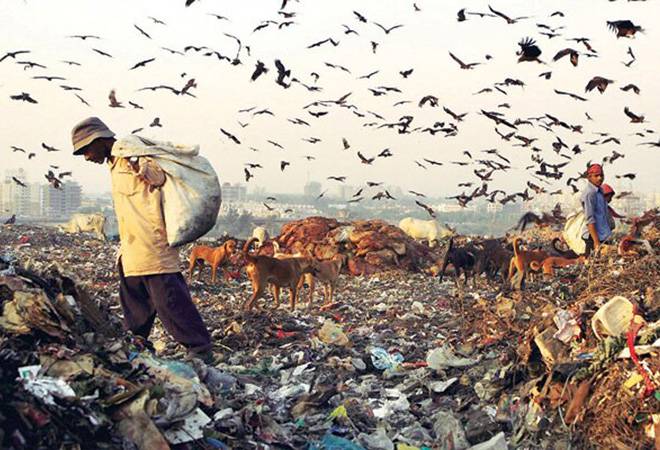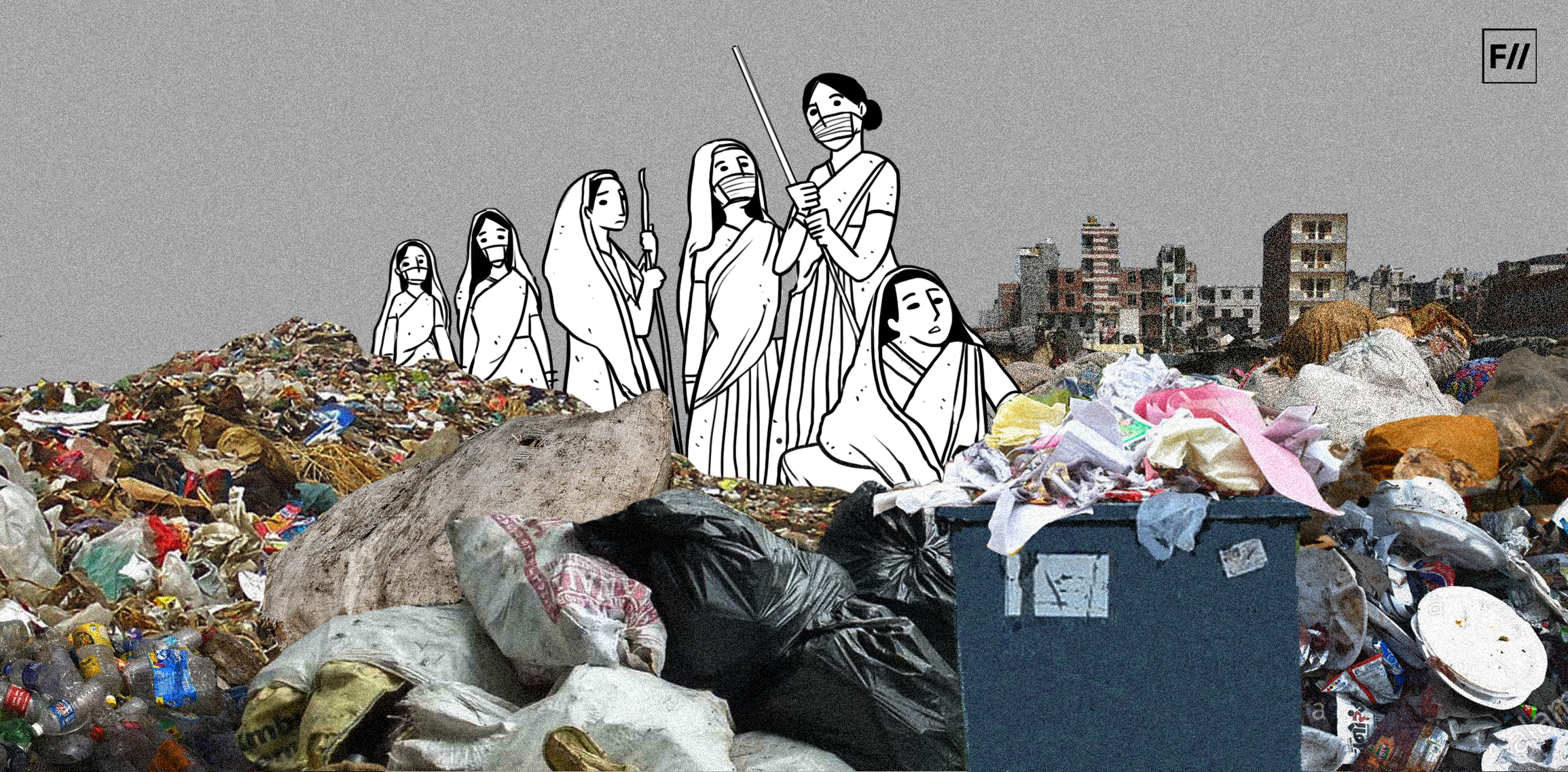Editor’s Note: This month, that is June 2020, FII’s #MoodOfTheMonth is Feminism And Environment, where we invite various articles about the diverse range of experiences which we often confront while interacting with our natural as well as social surroundings. If you’d like to share your article, email us at pragya@feminisminindia.com.
Changes in our environment and ecosystem have become normalised scenarios in current times. There is widespread acceptance that the way our communities and societies are modelled and run, needs reconsideration on grounds of sustainability if we plan to leave any resources for our future generations. A stream of images of turtles surrounded by plastic or mountains of landfills and garbage on the roads are just visuals that become quite commonplace.
While people advocate for using metal straws and have long discussions on ditching sanitary pads for menstrual cups, it becomes imperative to understand where this waste comes from, where it goes and who ultimately handles it. The following will be discussing primarily the management of solid waste, and briefly discuss biomedical and sewage waste with respect to its impact on the people who are involved within the industry at various levels.

Waste: Inside And Outside The House
Research shows that Delhi alone per day generates 11,000 tonnes of solid waste. This includes household waste along with industrial, hospital, commercial and construction waste. While recycling has not reached its full potential in Indian urban and rural spaces, landfills, burning of garbage and illegal dumping is abundantly found.
The journey of household waste sees many stakeholders, all of whom are not equal. It usually starts at door to door collection and makes its way to the garbage trucks. Waste dealers, kabariwallas and rag pickers find themselves in the system, mostly in the role of recycling. The recyclable waste is found from this garbage and then fetched a price for. Most cities have a nearby site where the majority of the waste is then dumped. Most of this goes untreated and is not recycled.
Industrial waste is often untreated, hazardous which may find its way to rivers, water bodies, and the landfills. In some cases, this may include nuclear waste from plants which is extremely harmful. While household waste may have anything from banana peels to milk pouches, the corporate kind is heavy in toxic materials which includes mercury, chrome, nickel, all known to cause a huge list of diseases, irreversible damage and death if one comes in contact with them.
The journey of household waste sees many stakeholders, all of whom are not equal. It usually starts at door to door collection and makes its way to the garbage trucks. Waste dealers, kabariwallas and rag pickers find themselves in the system, mostly in the role of recycling. The recyclable waste is found from this garbage and then fetched a price for. Most cities have a nearby site where the majority of the waste is then dumped. Most of this goes untreated and is not recycled.
What are the Effects of this Waste?
It’s safe to say that rotting and toxic waste is bound to be really harmful to humans and the environment.
Leaving it out in the open attracts flies and rodents which further transfers diseases. Burning of the garbage leads to respiratory problems. Landfills can also catch fire. Intentional and unintentional burning of garbage contributes heavily to air pollution in India. The hazardous chemicals which are absorbed by the land and water bodies contaminate both, making it toxic for human use.
However, most of this makes to known information; the zoomed-in picture involving actual human beings gets more horrifying. Those dumping the garbage and living near the landfills are at the constant hazard of a number of diseases. While there is easier access to masks against COVID-19 now, workers mostly do not get to use gear to keep them safe. The situation is also worse for those who live near the landfills. The rotting of the waste releases harmful fumes and gases. The rodents and insects make their way to their homes.
Burning of the waste not only creates fatal environment but also poses the risk of burning their homes. The land and water which is immediately accessible to them are saturated with toxicity. Biomedical waste produced by hospitals carry diseases that the waste pickers do not have the resources to get treatment for. Waste from all spheres, at various stages, affects the most vulnerable who are involved in it process.
Who Handles the Waste?
The sight of children on the street fishing for plastic isn’t uncommon in India. Shamefully so, since most people involved in the process of scavenging are extremely poor, malnourished children, susceptible to a number of illnesses and health condition. However, this includes just the rag pickers. There are people involved in the system such as kabadiwallas, employed by the contractors involved in the waste collection, and in the practice of manual scavenging. These are the same people exposed more so to the dangers with hardly any access to masks, gloves, proper clothing and shoes. They often work with their families, all exposed to these dangers. Primarily informal working conditions make it hard for them to seek any support for this at all. A huge number are migrants, mostly from rural areas, looking for better work opportunities.
Burning of the waste not only creates fatal environment but also poses the risk of burning their homes. The land and water which is immediately accessible to them are saturated with toxicity. Biomedical waste produced by hospitals carry diseases that the waste pickers do not have the resources to get treatment for. Waste from all spheres, at various stages, affects the most vulnerable who are involved in it process.
It is imperative to acknowledge that these people play an extremely important role in keeping the system in place. However, class, caste and gender are important factors here. It is clear that most people involved in waste management are inflicted by poverty and malnourishment, often working in informal conditions. While there have been protests which have talked about rights and improvement of their conditions, the scattered nature of the work makes it difficult to cover and ensure the betterment of conditions for all.
Caste
India’s deep-rooted relationship with the caste system becomes starkly clear in waste management. People’s view of waste is heavily influenced by the idea of purity and pollution. Most people would not touch garbage, much less reconsider being extremely discriminatory towards who are involved in this work. This makes them exist outside of the waste they generate. The ones in the system of waste management are often the castes that have been historically involved in the work. Working with families, this is passed on from one generation to the next. The worst manifestation of caste and politics of waste is coerced manual scavenging that claims lives and continues despite legal regulations.
Gender
Gender too operates in waste management due to the fact that waste itself can be said to be seen differently by different genders according to gender roles. At the household level, it may be women who are responsible for disposing off waste. The discourse of sustainable menstruation centres around the idea of reducing the waste produced during one’s menstrual cycle since the landfills consist of the used sanitary pads and tampons that are untreated and again, pose a health hazard. The onus of this waste generation is on the menstruators which includes a great percentage of women. However, those who do not get access to menstrual products are still expected to deal with it as waste at various levels. This leaves women at a more vulnerable position and more pushed to the unorganised sector of work.
Also read: Swachh Bharat Mission Hasn’t ‘Met’ Sustainable Menstruation. And That’s A Disaster | #ThePadEffect
India’s deep-rooted relationship with the caste system becomes starkly clear in waste management. People’s view of waste is heavily influenced by the idea of purity and pollution. Most people would not touch garbage, much less reconsider being extremely discriminatory towards who are involved in this work. This makes them exist outside of the waste they generate. The ones in the system of waste management are often the castes that have been historically involved in the work. Working with families, this is passed on from one generation to the next.
What Can We Do?
While there have the likes of Swacchh Bharat Abhiyan to tackle issues around cleanliness, there are various loopholes at many levels. It is now clear that the way waste management operates in urban India is highly determinantal to the people involved and the environment. So, the question arises, what can be done?
The first step is to make oneself aware of how waste management operates in the individual’s locality and city. Some basic research would be helpful to know where our waste goes and who ends up being affected by it the most.
Step two, would be to reach out to organisations and collectives who work in the field. It is also extremely important to understand the nexus of the rag pickers, people involved in the industry at various levels and their identities. For this, we need to draw attention to the invisiblisation of caste atrocities, and for those of our friends and family who refuse to acknowledge caste beyond affirmative action policies, believe gender equality has been achieved and think poverty is an individual problem—the change would begin with uncomfortable conversations about deeply rooted structures that form the entire system.
Also read: In Conversation With Bezwada Wilson: The Fight Against Manual Scavenging
Step three would be to push for waste segregation at the source rather than later on in the process which makes the possibility of its recycling and treatment achievable. However, this means that we not only educate ourselves about the waste we generate but also hold accountable huge industries and corporations who generate the humongous amount that is dumped into rivers and landfills. There are certain regulations in place for industries which need to be accounted for in their implementation. Years of protesting led to revised the rules by the Ministry of Environment on the effective collection, disposal and management, hence no step towards making a change in waste management is too small.
During this pandemic, the amount of waste generated in terms of disposable masks, sanitizers and other essentials by individuals and industries, as well as biomedical waste by hospitals as cases soar need attention and thorough consideration as cities deal with the effects of waste and run of land for landfills.
References
Featured Image Source: Feminism In India
About the author(s)
A spoken word poet, writer and a graphic design enthusiast, studying education. Passionate about a wide range of things, anywhere from political theory to queer representation to artificial intelligence.





I have gone through many articles on this site and it does seem that (a) there is no monitoring of the content; (b) the content producers are instructed to insert caste/community regardless of the topic; & (c) ignore various constitutional provisions, namely, Articles 14 & 15.
The onus of this waste generation is on the menstruators which includes a great percentage of women. However, those who do not get access to menstrual products are still expected to deal with it as waste at various levels. This leaves women at a more vulnerable position and more pushed to the unorganised sector of work.
What does the above paragraph mean? From the beginning to the end, the article is full of such meaningless statements. Why?